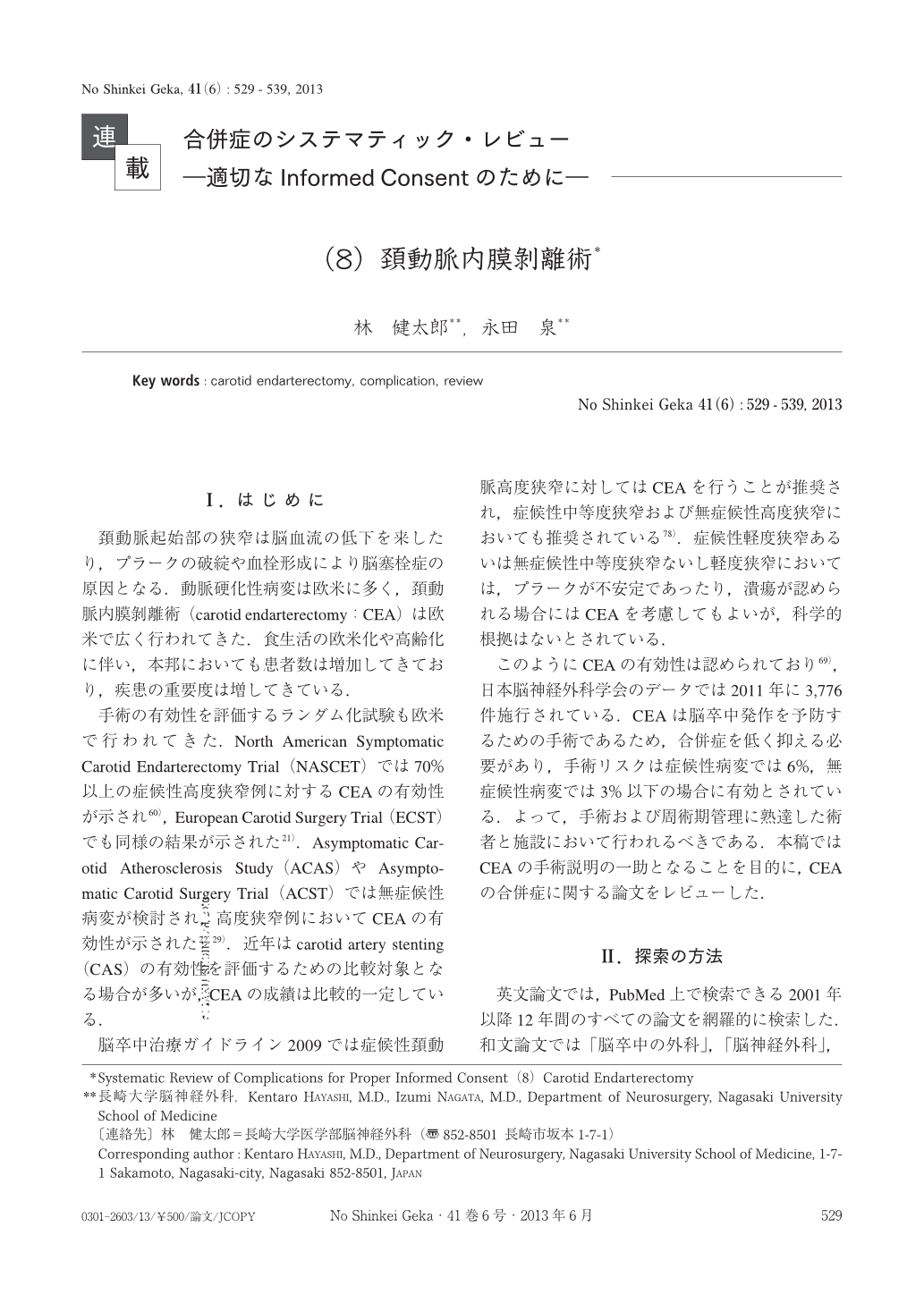2 0 0 0 OA C3-4頸髄症の臨床的検討
- 著者
- 角田 圭司 森川 実 永田 泉
- 出版者
- 日本脊髄外科学会
- 雑誌
- 脊髄外科 (ISSN:09146024)
- 巻号頁・発行日
- vol.23, no.1, pp.24-28, 2009 (Released:2017-05-11)
- 参考文献数
- 9
- 被引用文献数
- 2 2
The purpose of this study is to elucidate the characteristics of C3-4 level cervical spondylotic myelopathy. This study included 11 patients, 9 men and 2 women. Mean age at admission was 75.4 years. Clinically, all of the patients had clumsy hands and gait disturbance. There was also wooziness in 7 cases. This unusual symptom may contribute to late diagnosis. Radiologically, hypermobility at the C3-4 segment compensating for decreased mobility at lower segments may induce hypertrophy of the ligamentum flavum and disc bulging. This may be related to the occurrence of C3-4 level myelopathy.
2 0 0 0 OA もやもや病に対する直接バイパスの長期予後
- 著者
- 宮本 享 永田 泉 唐澤 淳 菊池 晴彦 秋山 義典 野崎 和彦 橋本 信夫
- 出版者
- 一般社団法人 日本脳卒中の外科学会
- 雑誌
- 脳卒中の外科 (ISSN:09145508)
- 巻号頁・発行日
- vol.28, no.2, pp.111-114, 2000-03-31 (Released:2012-10-29)
- 参考文献数
- 20
- 被引用文献数
- 9 7
We assessed the posttreatment clinical course of 113 patients with moyamoya disease. All of them were treated with superficial temporal artery-middle cerebral artery (STA-MCA) anastomosis with or without encephalo-myo-synangiosis. The mean follow-up duration was 14.4 years. Complete disappearance of the ischemic episodes was obtained in 110 patients (97.3%). Independent daily life activities were possible for 100 patients. Fifteen patients were incapable of social lives because of their mental retardation, although they can take care of themselves in their daily life. All of them suffered from preoperative completed stroke. Therepeutic time lag should be minimized to prevent these preoperative strokes.
- 著者
- 宮田 悠 中原 一郎 太田 剛史 松本 省二 定政 信猛 石橋 良太 五味 正憲 坂 真人 岡田 卓也 西 秀久 園田 和隆 高下 純平 渡邉 定克 永田 泉
- 出版者
- 一般社団法人 日本脳卒中の外科学会
- 雑誌
- 脳卒中の外科 (ISSN:09145508)
- 巻号頁・発行日
- vol.44, no.2, pp.145-150, 2016 (Released:2016-06-07)
- 参考文献数
- 13
- 被引用文献数
- 11 10
We report a case of repeated cerebral infarction caused by internal carotid artery (ICA) dissection triggered by an elongated styloid process, a form of Eagle syndrome. A 41-year-old man presented with sudden, mild left hemidysesthesia. Magnetic resonance imaging (MRI) revealed a small acute cerebral infarction in the right parietal cortex and insular cortex. Magnetic resonance angiography and digital subtraction angiography (DSA) revealed a right-sided ICA dissection distal to the carotid bifurcation. Idiopathic carotid artery dissection was suspected, and the patient was prescribed aspirin and observed. However, 5 months after the initial cerebral infarction, he had a second episode of left hemiparesis and confusion accompanied by occlusion of the right ICA. Because the area of impaired perfusion in the right hemisphere was greater than that suggested by the diffusion-weighted images of head MRI and clinical status was worse than expected, we performed acute revascularization with aspiration of the thrombus and stenting to treat the carotid dissection. Recanalization with thrombolysis of cerebral infarction (TICI)-grade IIB was achieved. Computed tomographic (CT) angiography combined with analysis of bony structures revealed close proximity of the right ICA and an elongated styloid process with its tip directed toward the dissection. In an angiographic suite, a dynamic cone beam CT was performed with the head of the patient variedly rotated and tilted; the carotid artery dissection appeared to be triggered by the elongated styloid process. Resection of this process was performed to prevent recurrence of the cerebral infarction. Under the guidance of a navigation system, the elongated styloid process, which was located ventral to the anterior belly of the digastric muscle, was cut 3 cm from the tip. The patient was discharged on postoperative day 8 without medical problems, and no recurrence was observed for 12 months after the surgery.
1 0 0 0 OA もやもや病,片側型もやもや病,類もやもや病に関する全国調査
- 著者
- 林 健太郎 堀江 信貴 陶山 一彦 永田 泉
- 出版者
- 一般社団法人 日本脳卒中の外科学会
- 雑誌
- 脳卒中の外科 (ISSN:09145508)
- 巻号頁・発行日
- vol.40, no.3, pp.179-182, 2012 (Released:2013-03-09)
- 参考文献数
- 21
- 被引用文献数
- 2 1
Moyamoya disease (MMD) is characterized by progressive occlusion of the internal carotid artery or its terminal branches, associated with formation of extensive collateral vessels (moyamoya vessels) at the base of the brain. Whether unilateral moyamoya disease, confirmed by typical angiographic evidence of moyamoya disease unilaterally and normal or equivocal findings contralaterally, is an early form of definite (bilateral) moyamoya disease remains controversial. Inherited or acquired disorders and conditions may present in conjunction with moyamoya disease. This condition is known as quasi-moyamoya disease (quasi-MMD). We attempted to determine the incidence and total patient number of moyamoya disease, unilateral MMD and quasi-MMD, who were treated during 2005 in Japan. Questionnaires were sent to 2,998 departments, which are listed in resident training programs of neurosurgery, neurology and pediatrics. Totally, 1,183 departments replied, and the response rate was 39.5%. The number of annual first-visit patients of MMD, unilateral MMD and quasi-MMD is 571, 118, and 53, respectively. Thus, the number of annual revisit patients of MMD, unilateral MMD and quasi-MMD is 2,064, 214, and 117 respectively. It is estimated that 6,670.9 MMD patient exists in Japan. The incidence rate of MMD, unilateral MMD and quasi-MMD is 1.13, 0.23 and 0.11/100,000, respectively, and the prevalence is 5.22, 0.66 and 0.34/100,000, respectively. This nationwide study revealed the present epidemic status of MMD, unilateral MMD and quasi-MMD.
1 0 0 0 (8)頚動脈内膜剝離術
Ⅰ.はじめに 頚動脈起始部の狭窄は脳血流の低下を来したり,プラークの破綻や血栓形成により脳塞栓症の原因となる.動脈硬化性病変は欧米に多く,頚動脈内膜剝離術(carotid endarterectomy:CEA)は欧米で広く行われてきた.食生活の欧米化や高齢化に伴い,本邦においても患者数は増加してきており,疾患の重要度は増してきている. 手術の有効性を評価するランダム化試験も欧米で行われてきた.North American Symptomatic Carotid Endarterectomy Trial(NASCET)では70%以上の症候性高度狭窄例に対するCEAの有効性が示され60),European Carotid Surgery Trial(ECST)でも同様の結果が示された21).Asymptomatic Carotid Atherosclerosis Study(ACAS)やAsymptomatic Carotid Surgery Trial(ACST)では無症候性病変が検討され,高度狭窄例においてCEAの有効性が示された22,29).近年はcarotid artery stenting(CAS)の有効性を評価するための比較対象となる場合が多いが,CEAの成績は比較的一定している. 脳卒中治療ガイドライン2009では症候性頚動脈高度狭窄に対してはCEAを行うことが推奨され,症候性中等度狭窄および無症候性高度狭窄においても推奨されている78).症候性軽度狭窄あるいは無症候性中等度狭窄ないし軽度狭窄においては,プラークが不安定であったり,潰瘍が認められる場合にはCEAを考慮してもよいが,科学的根拠はないとされている. このようにCEAの有効性は認められており69),日本脳神経外科学会のデータでは2011年に3,776件施行されている.CEAは脳卒中発作を予防するための手術であるため,合併症を低く抑える必要があり,手術リスクは症候性病変では6%,無症候性病変では3%以下の場合に有効とされている.よって,手術および周術期管理に熟達した術者と施設において行われるべきである.本稿ではCEAの手術説明の一助となることを目的に,CEAの合併症に関する論文をレビューした.
